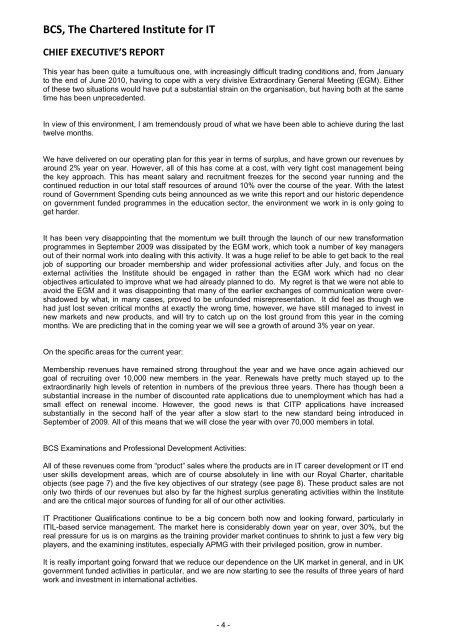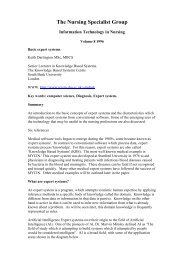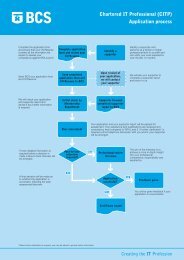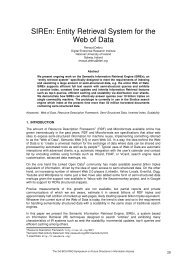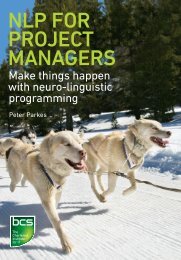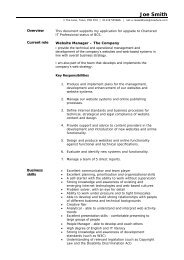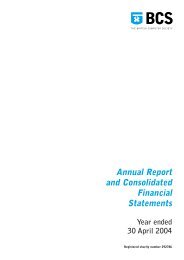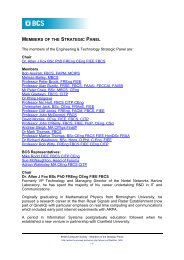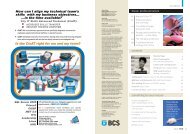BCS, The Chartered Institute for IT Annual Report and Consolidated ...
BCS, The Chartered Institute for IT Annual Report and Consolidated ...
BCS, The Chartered Institute for IT Annual Report and Consolidated ...
Create successful ePaper yourself
Turn your PDF publications into a flip-book with our unique Google optimized e-Paper software.
<strong>BCS</strong>, <strong>The</strong> <strong>Chartered</strong> <strong>Institute</strong> <strong>for</strong> <strong>IT</strong><br />
CHIEF EXECUTIVE’S REPORT<br />
This year has been quite a tumultuous one, with increasingly difficult trading conditions <strong>and</strong>, from January<br />
to the end of June 2010, having to cope with a very divisive Extraordinary General Meeting (EGM). Either<br />
of these two situations would have put a substantial strain on the organisation, but having both at the same<br />
time has been unprecedented.<br />
In view of this environment, I am tremendously proud of what we have been able to achieve during the last<br />
twelve months.<br />
We have delivered on our operating plan <strong>for</strong> this year in terms of surplus, <strong>and</strong> have grown our revenues by<br />
around 2% year on year. However, all of this has come at a cost, with very tight cost management being<br />
the key approach. This has meant salary <strong>and</strong> recruitment freezes <strong>for</strong> the second year running <strong>and</strong> the<br />
continued reduction in our total staff resources of around 10% over the course of the year. With the latest<br />
round of Government Spending cuts being announced as we write this report <strong>and</strong> our historic dependence<br />
on government funded programmes in the education sector, the environment we work in is only going to<br />
get harder.<br />
It has been very disappointing that the momentum we built through the launch of our new trans<strong>for</strong>mation<br />
programmes in September 2009 was dissipated by the EGM work, which took a number of key managers<br />
out of their normal work into dealing with this activity. It was a huge relief to be able to get back to the real<br />
job of supporting our broader membership <strong>and</strong> wider professional activities after July, <strong>and</strong> focus on the<br />
external activities the <strong>Institute</strong> should be engaged in rather than the EGM work which had no clear<br />
objectives articulated to improve what we had already planned to do. My regret is that we were not able to<br />
avoid the EGM <strong>and</strong> it was disappointing that many of the earlier exchanges of communication were overshadowed<br />
by what, in many cases, proved to be unfounded misrepresentation. It did feel as though we<br />
had just lost seven critical months at exactly the wrong time, however, we have still managed to invest in<br />
new markets <strong>and</strong> new products, <strong>and</strong> will try to catch up on the lost ground from this year in the coming<br />
months. We are predicting that in the coming year we will see a growth of around 3% year on year.<br />
On the specific areas <strong>for</strong> the current year:<br />
Membership revenues have remained strong throughout the year <strong>and</strong> we have once again achieved our<br />
goal of recruiting over 10,000 new members in the year. Renewals have pretty much stayed up to the<br />
extraordinarily high levels of retention in numbers of the previous three years. <strong>The</strong>re has though been a<br />
substantial increase in the number of discounted rate applications due to unemployment which has had a<br />
small effect on renewal income. However, the good news is that C<strong>IT</strong>P applications have increased<br />
substantially in the second half of the year after a slow start to the new st<strong>and</strong>ard being introduced in<br />
September of 2009. All of this means that we will close the year with over 70,000 members in total.<br />
<strong>BCS</strong> Examinations <strong>and</strong> Professional Development Activities:<br />
All of these revenues come from “product” sales where the products are in <strong>IT</strong> career development or <strong>IT</strong> end<br />
user skills development areas, which are of course absolutely in line with our Royal Charter, charitable<br />
objects (see page 7) <strong>and</strong> the five key objectives of our strategy (see page 8). <strong>The</strong>se product sales are not<br />
only two thirds of our revenues but also by far the highest surplus generating activities within the <strong>Institute</strong><br />
<strong>and</strong> are the critical major sources of funding <strong>for</strong> all of our other activities.<br />
<strong>IT</strong> Practitioner Qualifications continue to be a big concern both now <strong>and</strong> looking <strong>for</strong>ward, particularly in<br />
<strong>IT</strong>IL-based service management. <strong>The</strong> market here is considerably down year on year, over 30%, but the<br />
real pressure <strong>for</strong> us is on margins as the training provider market continues to shrink to just a few very big<br />
players, <strong>and</strong> the examining institutes, especially APMG with their privileged position, grow in number.<br />
It is really important going <strong>for</strong>ward that we reduce our dependence on the UK market in general, <strong>and</strong> in UK<br />
government funded activities in particular, <strong>and</strong> we are now starting to see the results of three years of hard<br />
work <strong>and</strong> investment in international activities.<br />
- 4 -


